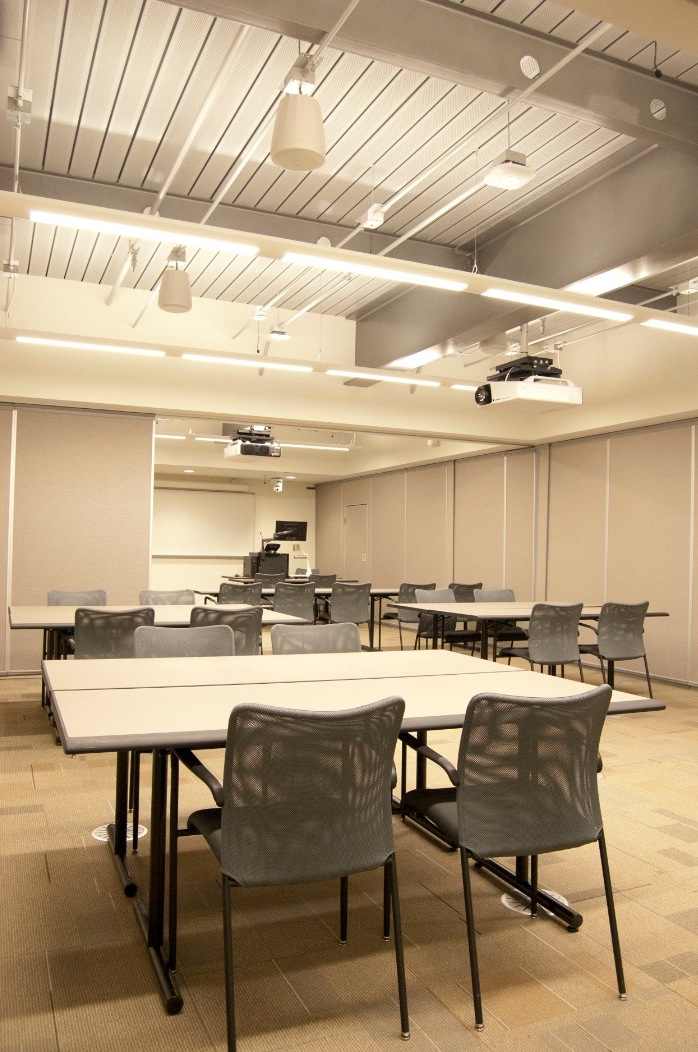For years, MEP engineers have debated the untapped potential lying within the walls and ceilings of virtually every modern commercial building: fire protection piping. Building owners sink a hefty sum into fire sprinkler infrastructure. Why not tap into this water distribution network for other uses, like toilet flushing?
Until recently, code officials have told Building Teams “hands off,” for fear of jeopardizing the integrity of these critical systems. But they are slowly coming around.
Two recent innovations are indicative of the trend. The first, the Fluid-Driven Sprinkler Light, utilizes a water turbine micro-generator with high-illumination LED light engines to provide emergency lighting without the need for batteries or other power sources (pictured above). Developed by the Industrial Technology Research Institute, the technology can provide for safer access and egress during fires, when buildings are engulfed by smoke.
High temperatures activate the sprinklers, and the flow of the water generates electricity to power the LEDs, which project a laser-based holography pattern light. The lights can be positioned to illuminate evacuation routes.
For the $29 million, four-level addition to the University of Michigan’s Institute for Social Research Expansion, in Ann Arbor, the engineering team, led by MEP engineer Peter Basso Associates, utilized the building’s fire protection piping system to distribute chilled water to the chilled beams (pictured, below). The dual-function design eliminated approximately 70% of the piping normally associated with a chilled beam system, and reduced first cost by an estimated $500,000.
It is the first installation of its kind in the U.S., and it required that all components of the combined fire protection/chilled beam system be rated for a minimum 175 PSIG (pounds per square inch gage) operating pressure, according to Brian Runde, PE, LEED AP, VP with Peter Basso Associates. He says using chilled beams helped the project reduce overall building energy use by 37.2% versus an ASHRAE 90.1-compliant building.
 Photo: Peter Basso Associates
Photo: Peter Basso Associates
Related Stories
Design Innovation Report | Apr 27, 2023
BD+C's 2023 Design Innovation Report
Building Design+Construction’s Design Innovation Report presents projects, spaces, and initiatives—and the AEC professionals behind them—that push the boundaries of building design. This year, we feature four novel projects and one building science innovation.
Design Innovation Report | Apr 19, 2023
Reinforced concrete walls and fins stiffen and shade the National Bank of Kuwait skyscraper
When the National Bank of Kuwait first conceived its new headquarters more than a decade ago, it wanted to make a statement about passive design with a soaring tower that could withstand the extreme heat of Kuwait City, the country’s desert capital.
Design Innovation Report | Apr 19, 2023
HDR uses artificial intelligence tools to help design a vital health clinic in India
Architects from HDR worked pro bono with iKure, a technology-centric healthcare provider, to build a healthcare clinic in rural India.
3D Printing | Apr 11, 2023
University of Michigan’s DART Laboratory unveils Shell Wall—a concrete wall that’s lightweight and freeform 3D printed
The University of Michigan’s DART Laboratory has unveiled a new product called Shell Wall—which the organization describes as the first lightweight, freeform 3D printed and structurally reinforced concrete wall. The innovative product leverages DART Laboratory’s research and development on the use of 3D-printing technology to build structures that require less concrete.
Cladding and Facade Systems | Apr 5, 2023
Façade innovation: University of Stuttgart tests a ‘saturated building skin’ for lessening heat islands
HydroSKIN is a façade made with textiles that stores rainwater and uses it later to cool hot building exteriors. The façade innovation consists of an external, multilayered 3D textile that acts as a water collector and evaporator.
Transportation & Parking Facilities | Mar 23, 2023
Amsterdam debuts underwater bicycle parking facility that can accommodate over 4,000 bikes
In February, Amsterdam saw the opening of a new underwater bicycle parking facility. Located in the heart of the city—next to Amsterdam Central Station and under the river IJ (Amsterdam’s waterfront)—the facility, dubbed IJboulevard, has parking spots for over 4,000 bicycles, freeing up space on the street.
Concrete | Jan 24, 2023
Researchers investigate ancient Roman concrete to make durable, lower carbon mortar
Researchers have turned to an ancient Roman concrete recipe to develop more durable concrete that lasts for centuries and can potentially reduce the carbon impact of the built environment.
Sponsored | Resiliency | Dec 14, 2022
Flood protection: What building owners need to know to protect their properties
This course from Walter P Moore examines numerous flood protection approaches and building owner needs before delving into the flood protection process. Determining the flood resilience of a property can provide a good understanding of risk associated costs.
Giants 400 | Nov 14, 2022
4 emerging trends from BD+C's 2022 Giants 400 Report
Regenerative design, cognitive health, and jobsite robotics highlight the top trends from the 519 design and construction firms that participated in BD+C's 2022 Giants 400 Report.
AEC Tech | Apr 13, 2022
A robot automates elevator installation
Schindler—which manufactures and installs elevators, escalators, and moving walkways—has created a robot called R.I.S.E. (robotic installation system for elevators) to help install lifts in high-rise buildings.















